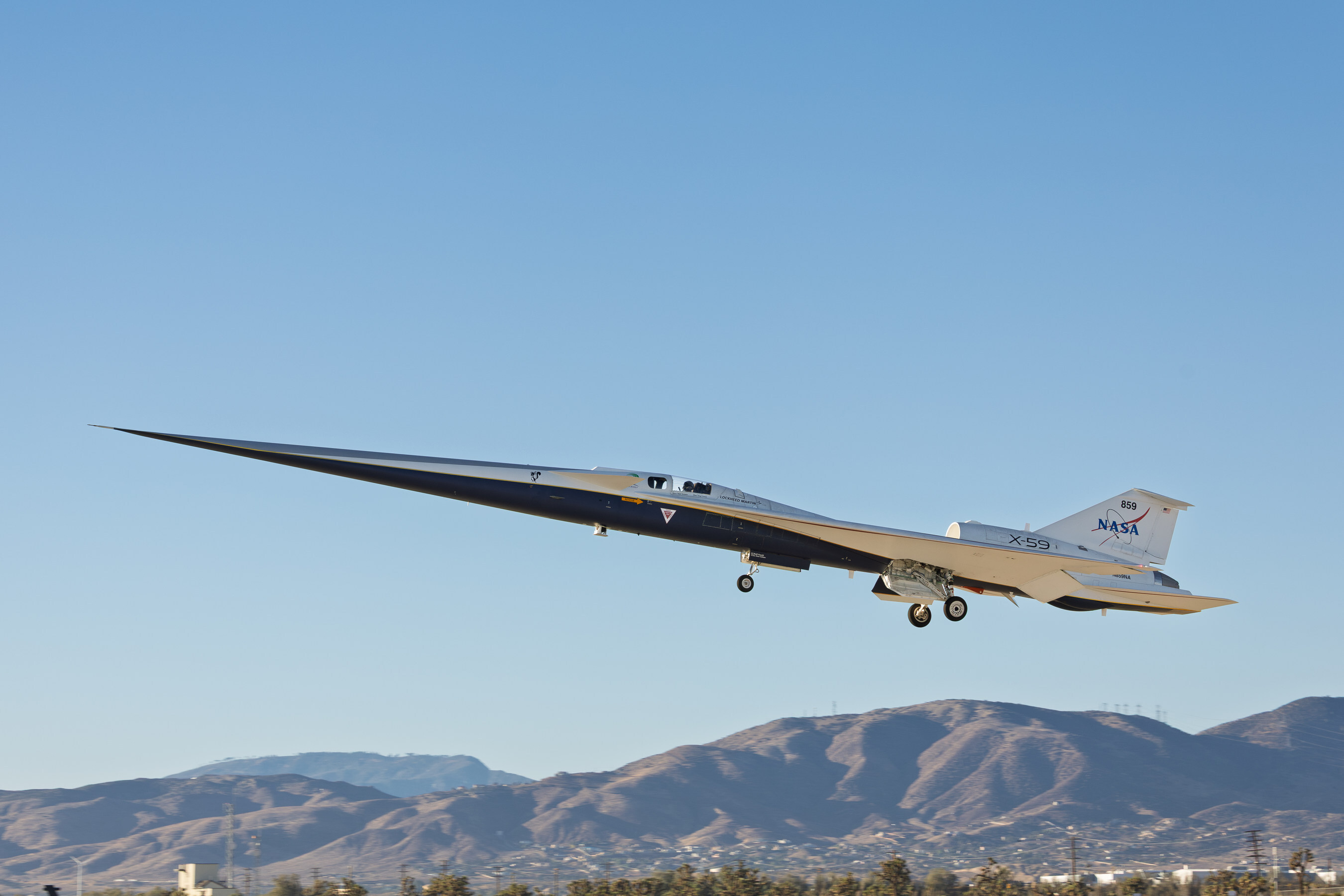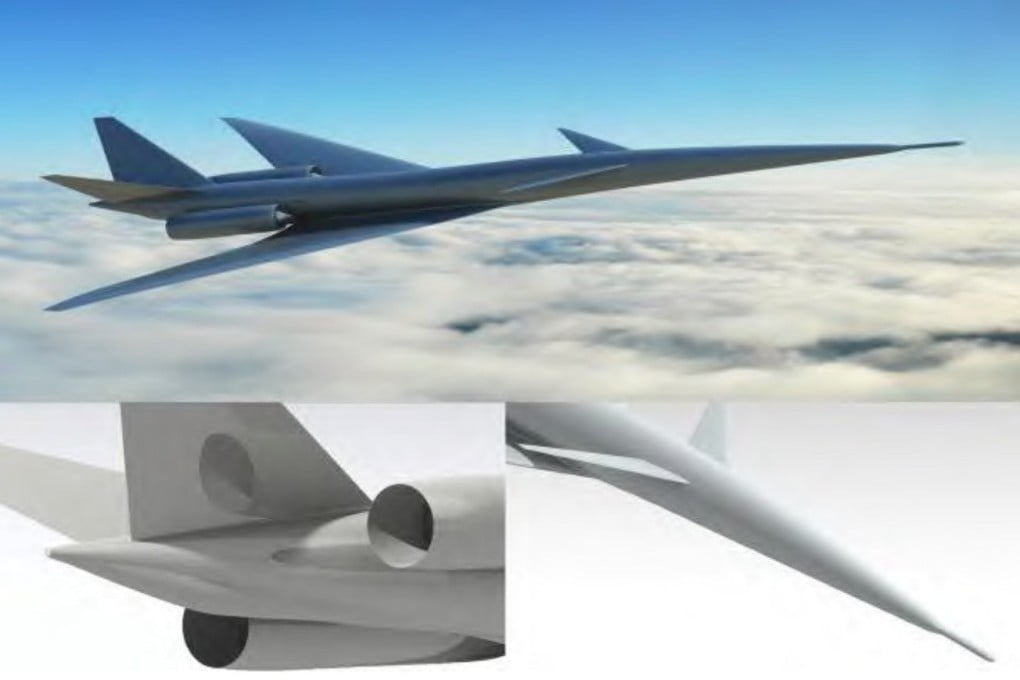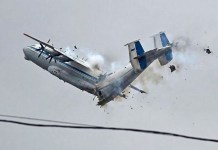The United States has taken a massive leap in making supersonic commercial travel a reality with the first flight of its X-59 quiet supersonic aircraft.
The Lockheed Martin X-59 is a groundbreaking experimental supersonic aircraft developed by Lockheed Martin’s Skunk Works division in partnership with NASA as part of the QueSST (Quiet SuperSonic Technology) program. The maiden flight of the aircraft was announced by Lockheed in an official press statement on October 28.
When an aircraft goes supersonic, or faster than the speed of sound, it generates a sonic boom or a loud thunder-like sound. The X-59 is a revolutionary aircraft that would be able to fly supersonic without generating the painful sonic boom, which has been banned in the United States due to the disruptive impact it has on the communities below.
For its first flight, the experimental aircraft took off from the Skunk Works’ facility at U.S. Air Force Plant 42 in Palmdale, California, and touched down near NASA’s Armstrong Flight Research Center in Edwards, California. The aircraft operated as planned, confirming its initial flying characteristics and air data performance, the press statement noted.
“We are thrilled to achieve the first flight of the X-59,” OJ Sanchez, vice president and general manager of Lockheed Martin Skunk Works, was quoted as saying. “This aircraft is a testament to the innovation and expertise of our joint team, and we are proud to be at the forefront of quiet supersonic technology development.”
Exuding optimism in this state-of-the-art aircraft, Sean Duffy, acting NASA Administrator, said, “X-59 is a symbol of American ingenuity. The American spirit knows no bounds. It’s part of our DNA – the desire to go farther, faster, and even quieter than anyone has ever gone before. This work sustains America’s place as the leader in aviation and has the potential to change the way the public flies.”
For further testing, the experimental aircraft will be moved to NASA’s Armstrong Flight Research Center. Skunk Works will continue to spearhead the X-59’s first flight test campaign in the coming months while collaborating closely with NASA to increase the aircraft’s flight envelope. The testing will be centered around the X-59’s initial supersonic flights, in which the aircraft reaches the ideal speed and altitude for a silent boom.

The first flight comes nearly 20 months after the experimental aircraft was rolled out in January 2024. At the time, NASA Deputy Administrator Pam Melroy said, “In just a few short years, we’ve gone from an ambitious concept to reality. NASA’s X-59 will help change how we travel, bringing us closer together in much less time.”
Developed countries with deep purses and access to the best engineers in the world have worked on the development of supersonic travel for decades. During the Cold War, the Western Bloc (France and the United Kingdom) and the Soviet Union fought fiercely to be the first to design and field a supersonic aircraft for commercial use.
Much like the space race, the race to develop a supersonic airliner was won by the Soviets, with the Tupolev Tu-144 being their Sputnik moment
The Tu-144 was the world’s first supersonic aircraft, ahead of the Anglo-French Concorde. In fact, the Tu-144 beat the Anglo-French Concorde in the skies twice: it had its maiden flight on December 31, 1968, two months before Concorde, and then achieved its first supersonic flight in June 1969, beating the competition by four months.
Interestingly, there were claims that the Soviets had stolen the plans for the Concorde, which probably helped them create the Tupolev Tu-144 before the Concorde. Nonetheless, both the Tu-144 and Concorde programs had to be canceled due to significant defects, poor safety records, and economic viability.
Cut to four decades later, the biggest US rival, China, is also diligently working on a quiet supersonic civilian aircraft. In March this year, engineers of the Chinese state-owned aerospace giant Comac revealed the first details of C949, a supersonic airliner project.

In a paper published in the journal Acta Aeronautica Sinica, a team of engineers noted that the aircraft would have a 50% increase in range compared to the Concorde, and a reduction in sonic booms to 83.9 PLdB, which is about the same noise level as a hairdryer.
Interestingly, the COMAC C949 might share some design similarities with NASA’s X-59, as both seem to adopt the “long dart/needle-nose” low-boom philosophy to slash sonic booms for overland supersonic flight.
This essentially means that the C949 is competing with similar projects from other countries, such as X-59. Therefore, the success of the X-59 Quesst program will not only make supersonic travel a reality but also position the US as the leader of supersonic aviation, ahead of its rivals.
The Supersonic Marvel That Is X-59
The development of X-59 is fascinating because it doesn’t defy the rule of physics, but seeks to cleverly work within them to achieve something that feels, and may be, truly revolutionary.
When an aircraft flies supersonic (Mach 1+), it generates shock waves from pressure disturbances at the nose, wings, canopy, engine inlets, and tail. In a conventional design, these shocks merge close together behind the aircraft, forming a single, powerful N-shaped pressure wave. When this hits the ground, it creates the classic loud sonic boom, typically comparable to a nearby gunshot or thunderclap.
The X-59 project, originating in 2016, initially aimed for its first flight in 2020. However, due to various technical challenges, NASA’s QueSST team encountered delays, pushing the flight schedule much farther. The first flight, announced recently, was preceded by integrated systems testing, engine runs, and taxi testing.
The aircraft, which has a single jet engine and is 99.7 feet long and 29.5 feet broad, will be flown by a single pilot. It is expected to have a design research speed of Mach 1.4, or 925 mph, flying at 55,000 feet. Notably, nearly one-third of the aircraft’s length is made up of a thin, tapered nose that is designed to disperse shock waves, which are usually responsible for the disruptive sonic booms that surround supersonic aircraft.
If not for this distinguished nose, there would be a highly noticeable acoustic boom on the ground due to these shock waves.
Besides the nose, some other steps have been taken to improve the X-59’s supersonic capabilities. For instance, the forward-facing windows that are typically present in conventional airplanes have been removed, and the cockpit has been placed about midway down the length. Instead, the pilot sees the outer world through the eXternal Vision System (XVS), which was specifically designed for the aircraft. This uses several high-definition cameras that send data to a 4K monitor located in the cockpit.
The location of the engine is also intriguing. It is located on the top of the rear of the fuselage to help stop supersonic shockwaves from accumulating behind the aircraft and producing a sonic boom. The X-59 is powered by the F414-GE-100 turbofan.
The successful completion of initial flight testing will mark the conclusion of the first phase of the QueSST project.
The subsequent phase at Armstrong signifies a more intensive phase of work. The second phase of the QueSST program would focus on validating the core design through flights in the supersonic test range over Edwards Air Force Base.
Moving into the third phase, the Community Response Study, the X-59 will undertake flights over various locations in the US. During this time, the individuals in these different locations will provide feedback on the noise using push notifications to their mobile phones.
The third phase was previously projected between 2025 and 2026, but may now be delayed. The specific communities earmarked for this stage remain undisclosed, but NASA had previously hinted at the potential involvement of four to six cities scattered across the nation in this comprehensive research.
The X-59 is essentially an experiment whose successful development and flight testing will inform the establishment of new data-driven acceptable noise thresholds related to supersonic commercial flight over land, according to Lockheed. This will pave the way for a new generation of supersonic aircraft that can efficiently and sustainably transport passengers and cargo twice as fast as aircraft today.
Once operational, the new American supersonic aircraft will be the first supersonic airliner to take to the skies after the Concorde.
- Contact the author at sakshi.tiwari13 (at) outlook.com
- Follow EurAsian Times on Google News




